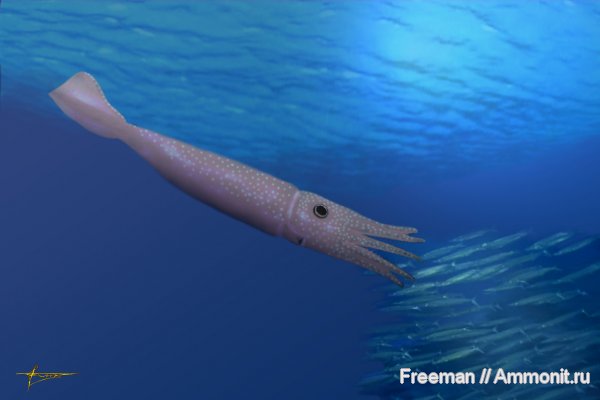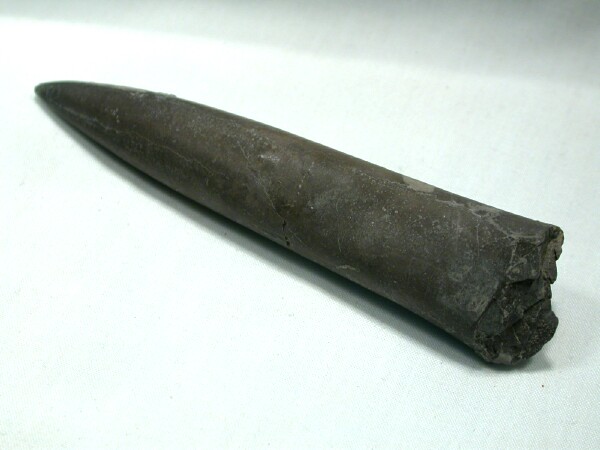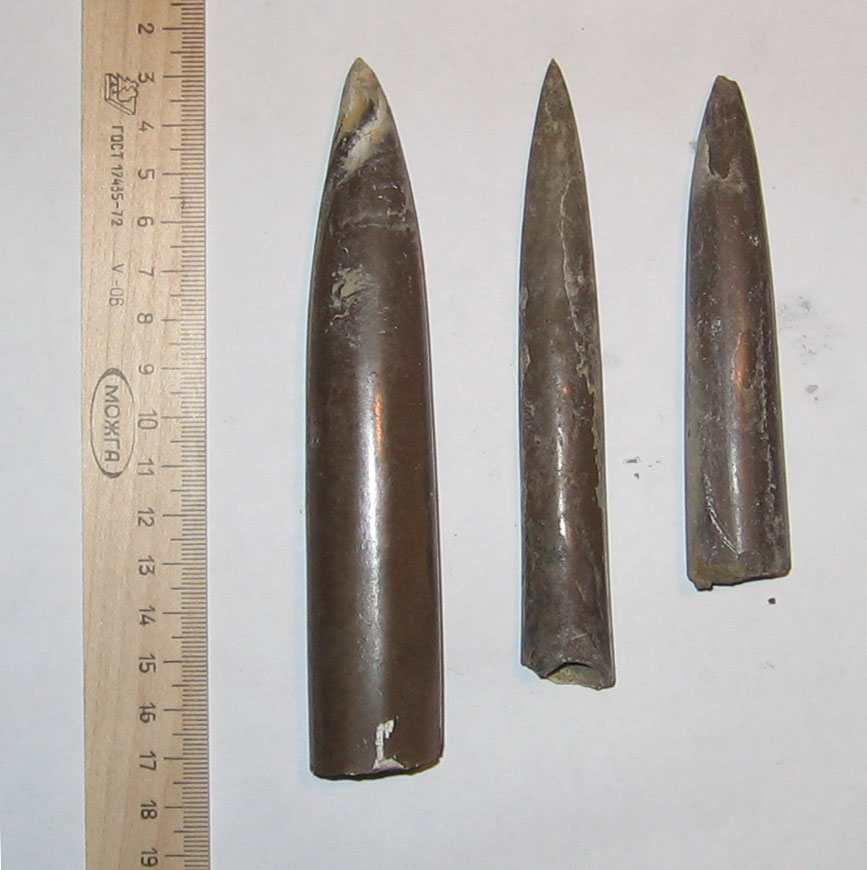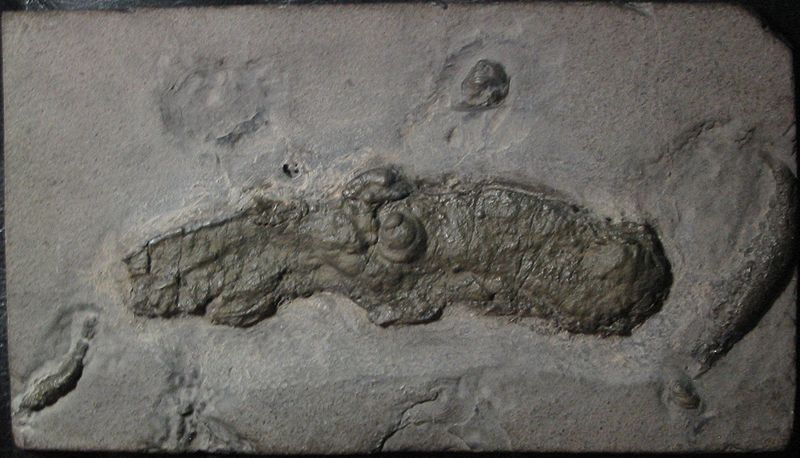[Recent Entries][Archive][Friends][User Info]
April 1st, 2012
| April 1st, 2012 | |
|---|---|
| 04:19 pm [industrialterro] [Link] |
Cylindroteuthis Cylindroteuthis is a genus of belemnite that lived from the Early Jurassic to the Early Cretaceous. Its fossils have been found in Asia, Europe, North America, and New Zealand. Cylindroteuthis was first described in 1879 by Claude-Emile Bayle. A belemnite originally described as the Cylindroteuthis species C. confessa has been re-described as Mesoteuthis soloniensis. Cylindroteuthis is a common find from several Jurassic formations. Specimen length ranges from 4 inches (10 cm) to 8.5 inches (22 cm). The most commonly preserved part of the animal is its guard, or rostrum, which was composed of calcite. The guard would not have been found on the exterior of Cylindroteuthis, as traces of blood vessels have been discovered on some guards, suggesting that it was an internal feature. The guard housed a phragmocone, which allowed Cylindroteuthis to maintain buoyancy in water. Some better-preserved specimens have features similar to modern squid, such as ten arm-like appendages and an ink sac, intact. Cylindroteuthis has been recovered from the Temaikan Boatlanding Bay formation of Australasia. Three species of Cylindroteuthis (C. knoxvillensis, C. cf. newvillensis, and C. venusta) have been described from the Arctic region. In addition, about 2350 belemnite guards (including those of Cylindroteuthis) have been recovered from Lower Cretaceous formations of northeastern Greenland, suggesting the presence of a sort of "immigration route" for belemnites. The findings also suggest the existence of a "proto Gulf-stream" as early as the Valanginian.
Tags: Вымершие беспозвоночные, Юра |
| Time | Event |
| 04:38 pm [industrialterro] [Link] |
Vampyronassa Vampyronassa rhodanica is an extinct vampyromorph cephalopod known from around 20 fossils from the Lower Callovian (165–164 Ma) of La Voulte-sur-Rhône, Ardèche, France. It differs from the modern Vampire Squid in having longer first dorsal arms, a larger hyponome, and a more elongated mantle.
Tags: Вымершие беспозвоночные, Юра |
| Time | Event |
| 04:54 pm [industrialterro] [Link] |
Trachyteuthis Trachyteuthis is a genus of fossil teuthid, comprising four species: T. hastiformis, T. nusplingensis, T. teudopsiformis, and T. covacevichi. The taxonomic placement of Trachyteuthis is uncertain. Though often assigned to the order Vampyromorphida, the discovery of fossilised Trachyteuthis beaks in the Upper Jurassic limestone of Germany suggests a close phylogenetic relation to the Octopoda. It is clear that it does at least belong in the Coleoidea. It is thought to be very closely related to Teudopsis. Fossils are scarce but have been reported from the Kimmeridge clay of the UK; the Solenhofen limestone of Germany, Jurassic deposits in Antarctica, and Oxfordian deposits in Chile. First described in 1773 as the remnants of a fish, Trachyteuthis was considered comparable to a Sepia cuttlebone by Rüppell in 1829. A separate genus was erected for the material in 1846 by Meyer. English material was discovered in 1855 and termed Coccoteuthis latipinnis; this was later synonymised with the identical Solnhofen deposits. A 2007 survey of museum collection established that there were ground for the erection of three species within the genus.
Tags: Вымершие беспозвоночные, Юра |
| Time | Event |
| 05:47 pm [industrialterro] [Link] |
Nephila jurassica Nephila jurassica — ископаемый вид пауков, найденный в Китае (англ. Jiulongshan Formation, Daohugou Village, Wuhua Township, Ningcheng County, Внутренняя Монголия; 41°19.532′ N, 119°14.589′ E). Nephila jurassica обитал в Юрском периоде около 165 млн лет назад. Размах ног гигантского ископаемого паука достигал 15 сантиметров. При этом само тело (головогрудь + брюшко) имело длину около 5 см. Описание сделано по единственной самке (голотип CNU-ARA-NN2010008, College of Life Sciences, Capital Normal University, Пекин). Китайские исследователи полагают, что обнаруженный вид обитал в тропических лесах на праконтиненте Пангея. Гигантского ископаемого паука, размах лап которого превышает 15 сантиметров, нашли в юрских отложениях в Китае. Прекрасно сохранившийся отпечаток палеонтологи обнаружили в слоях вулканического пепла в провинции Внутренняя Монголия. Паук получил название Nephila jurassica. Он жил в самом конце келловейского века средней юры, примерно 165 миллионов лет назад.
Tags: Вымершие членистоногие, Юра |
| Time | Event |
| 06:21 pm [industrialterro] [Link] |
Eoplectreurys Eoplectreurys is an extinct monotypic genus of spider from the family Plectreuridae, with a sole species, Eoplectreurys gertschi. The fossils of Eoplectreurys were recovered from the 165 Ma old Middle Jurassic Daohugou formation tuffs in Inner Mongolia, China. The type specimens are deposited in the Nanjing Institute of Geology and Palaeontology with the genus being described from a total of seven adult spiders. Eoplectreurys was first studied and described by Drs Paul Selden and Diying Huang, who published their type description in the journal Naturwissenschaften in 2010. The genus name is a combination of the Greek word eos which means "dawn", and Plectreurys the name of the modern genus which the fossils closely resemble. Eoplectreurys is considered the oldest described spider genus of the Haplogynae series, predating the described Haplogynae spiders from Cretaceous ambers in Jordan and Lebanon, and is the oldest member of Plectreuridae. The two other Plectreuridae species described from fossils are both known from specimens preserved in amber with Palaeoplectreurys baltica from Eocene Baltic amber and Plectreurys pittfieldi from early Miocene Dominican amber. The modern distribution of Plectreuridae is restricted to Southwestern North America, Central America, and parts of the Greater Antilles. The current restricted range of the family may be due to either the severe cooling at the Eocene-Oligocene transition or the Pliocene-Pleistocene ice age. The specimens of Eoplectreurys are preserved as compression fossils in the fine-grained lacustrian rocks and thus have been flattened from their dimensions in life. Due to the lack of exterior genitalia on females, it is very difficult to identify possible Eoplectreurys females from among the number of Haplogynae spiders found in the Daohugou formation. Only one specimen is a possible match, having a carapace which is round as in the Eoplectreurys males, while the other known Haplogynae female specimens possess elongated carapaces. Only one other family of spiders, Segestriidae, is similar to the fossils. However the legs of Segestriidae have more spines than the fossils and the overall carapace shape of Segestriids is elongated, with maxillae which do not meet in front of the labium. On average Eoplectreurys was a small spider with the average body length, not including legs, being 3 millimetres (0.30 cm). The fossils display fused chelicerae, distinctly short legs, and are ecribellate, that is, without the silk spinning organ called a cribellum. The number of eyes is not distinguishable in the fossils and the stridulating file which is found on the pedipalps are not apparent or not present. Eoplectreurys is most similar in structure to the P. tristis group of Plectreurys. The species lived around a lake in a volcanically active area and was found in fine-grained volcanic ash lacustrine (lake-bed) deposits, the ash helping to preserve the specimens. Ученые обнаружили на севере Китая прекрасно сохранившиеся останки паука возрастом 165 миллионов лет. Статья ученых появилась в журнале Naturwissenschaften, а ее краткое изложение приводит издание Wired. Обнаруженное паукообразное относится к виду Eoplectreurys gertschi и обитало в юрском периоде. По словам ученых, возраст прежних представителей этого вида составлял не более 120 миллионов лет. Исследователи подчеркивают, что у обнаруженного паука присутствуют многие признаки, характерные для современных представителей паукообразных. Это означает, что за последние 165 миллионов лет пауки не сильно изменились. Кроме того, регион обнаружения нового вида указывает на то, что семейство Plectreuridae, к которому относится E. gertschi, в прошлом было достаточно широко (в географическом плане) распространено. Позже ареал обитания этих пауков сократился, вероятно, из-за климатических изменений. По словам ученых, обнаружение хорошо сохранившихся останков пауков является для палеонтологов большой удачей, поскольку мягкие ткани паукообразных обычно быстро разрушаются. В данном случае, однако, E. gertschi попал под слой вулканического пепла, частицы которого не нарушили целостность его кутикулы. Совсем недавно ученые установили, что вид Attercopus fimbriunguis , который является одним из древнейших из известных на сегодняшний день паукообразных (возраст имеющихся образцов составляет около 383 миллионов лет), был не способен плести паутину. Отсюда ученые заключили, что A. fimbriunguis не может считаться пауком.
Tags: Вымершие членистоногие, Юра |
| Time | Event |
| 06:41 pm [industrialterro] [Link] |
Mesolimulus Mesolimulus is an extinct genus of arthropod. The best known examples are found in Solnhofen limestone near Solnhofen, Bavaria, Germany. Originally assigned to the living genus Limulus, they are related to and look virtually identical to the modern horseshoe crab. Other species assigned to Mesolimulus have been recorded from Spain, Siberia and (questionably) from Lebanon. The unusual trackways left by these animals at Solnhofen were originally thought to have been made by birds or pterosaurs, since they included a cross-shaped marking comparable with the impression of a typical bird foot. Eventually they were correctly identified as arthropod footprints and named Kouphichnium walchi, as proved by some remarkable 'death traces' showing a Mesolimulus circling round on itself before dying. The last leg of more advanced horseshoe crabs is modified into a so-called 'pusher' which consists of four plates at the tip which push against the soft sediment rather like a snow-shoe. This was what left the unusual bird-like footprints. Horseshoe crabs in general date to the Ordovician Period, more than 440 million years ago, and late Paleozoic Euproops fossils indicate that they have changed little over the last 300 million years. Fossils preserved in Solenhofen limestone are unusual because soft body parts and skeletons are clearly represented. Мечехвосты появились в кембрийском периоде и дожили до наших дней, не испытав принципиальных перемен в строении (обширный головогрудной щит и длинный хвостовой шип, используемый для упора в грунт при рытье осадка) и, видимо, в образе жизни: мезолимулюс был крупным придонным хищником и падалеядом. Современные мечехвосты (4 вида) живут на литорали и в лагунах Карибского моря и Тихого океана; длина их тела достигает 70 см. Мезозойские мечехвосты (к числу которых относится мезолимулюс) были гораздо мельче, и обитали в пресных водах.
Tags: Вымершие членистоногие, Юра |
| Previous Day | 2012/04/01 [Archive] |
Next Day |




















